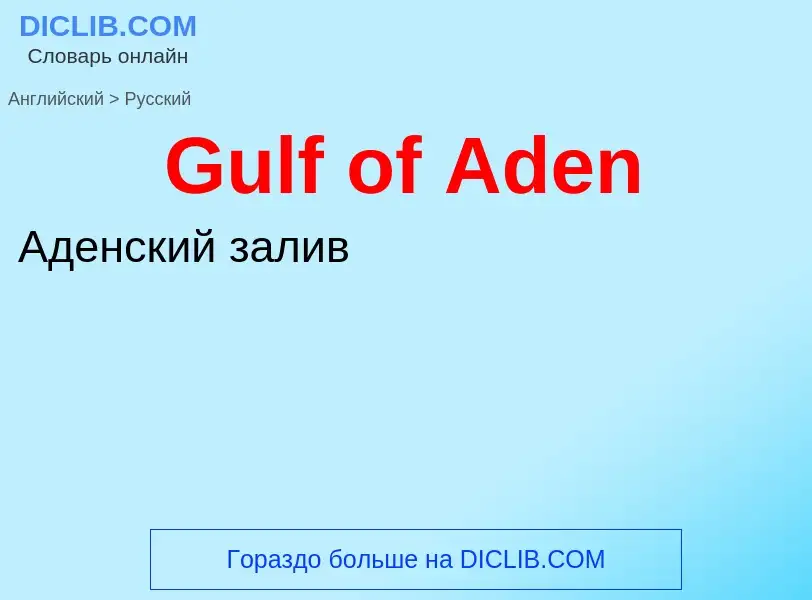Translation and analysis of words by ChatGPT artificial intelligence
On this page you can get a detailed analysis of a word or phrase, produced by the best artificial intelligence technology to date:
- how the word is used
- frequency of use
- it is used more often in oral or written speech
- word translation options
- usage examples (several phrases with translation)
- etymology
Gulf of Aden - translation to russian
Definition
.
Wikipedia

The Gulf of Aden (Arabic: خليج عدن, Somali: Gacanka Cadmeed 𐒅𐒖𐒐𐒕𐒌 𐒋𐒖𐒆𐒗𐒒) is a deepwater gulf of the Indian Ocean between Yemen to the north, the Arabian Sea to the east, Djibouti to the west, and the Guardafui Channel, Socotra and Somalia to the south. In the northwest, it connects with the Red Sea through the Bab-el-Mandeb strait, and it connects with the Arabian Sea to the east. To the west, it narrows into the Gulf of Tadjoura in Djibouti. The Aden Ridge lies along the centerline of the Gulf and is causing it to widen about 15mm per year.
The ancient Greeks regarded the gulf as one of the most important parts of the Erythraean Sea. It later came to be dominated by Muslims, as the area around the gulf converted to Islam. From the late 1960s onwards, there started to be an increased Soviet naval presence in the Gulf. The importance of the Gulf of Aden declined when the Suez Canal was closed, but it was revitalized when the canal was reopened in 1975, after being deepened and widened by the Egyptian government.
The waterway is part of the important Suez Canal shipping route between the Mediterranean Sea and the Arabian Sea in the Indian Ocean, with 21,000 ships crossing the gulf annually. This route is often used for the delivery of Persian Gulf oil, making the gulf an integral waterway in the world economy. Important cities along the Gulf of Aden include the namesake Aden in Yemen. Other Yemeni cities are Zinjibar, Shuqrah, Ahwar, Balhaf, Mukalla. On the Horn African side, the cities of Djibouti, Berbera and Bosaso.
Despite a lack of large-scale commercial fishing facilities, the coastline supports many isolated fishing towns and villages. The Gulf of Aden is richly supplied with fish, turtles, and lobsters. Local fishing takes place close to the shore; sardines, tuna, kingfish, and mackerel make up the bulk of the annual catches. Crayfish and sharks are also fished locally.


![A [[dhow]] in the Gulf of Aden A [[dhow]] in the Gulf of Aden](https://commons.wikimedia.org/wiki/Special:FilePath/Dhow Gulf of Aden.jpg?width=200)
![Ibn Majid]] referring to the Gulf as the ''Gulf of [[Berbera]]'' Ibn Majid]] referring to the Gulf as the ''Gulf of [[Berbera]]''](https://commons.wikimedia.org/wiki/Special:FilePath/Ibn Majid Gulf of Berbera.png?width=200)


![The city of [[Aqaba]] is the largest on the gulf The city of [[Aqaba]] is the largest on the gulf](https://commons.wikimedia.org/wiki/Special:FilePath/Aqaba3.jpg?width=200)
![David Roberts]]. David Roberts]].](https://commons.wikimedia.org/wiki/Special:FilePath/Isle of Graia (crop).jpg?width=200)

![[[Coral World Underwater Observatory]] at [[Eilat]] [[Coral World Underwater Observatory]] at [[Eilat]]](https://commons.wikimedia.org/wiki/Special:FilePath/The Underwater Observatory in Eilat.jpg?width=200)
![Taba]] beach Taba]] beach](https://commons.wikimedia.org/wiki/Special:FilePath/Hilton hotel taba egypt.jpg?width=200)

![A resort near [[Eilat's Coral Beach]] A resort near [[Eilat's Coral Beach]]](https://commons.wikimedia.org/wiki/Special:FilePath/Gulf of Eilat.jpg?width=200)
